

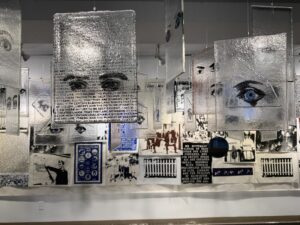
photograph by Henry Matthews
Christina Reed’s exhibition “Reckoning” confronts us with our own whiteness and oblivous racism head on and with ingenuity.
The exhibition consists of three parts. The first is Reflection, a wall filled with large black and white prints based on historical photographs of white people: juries, business men, families, picket fences, interspersed with the words of the declaration of independence, maps of redlining.
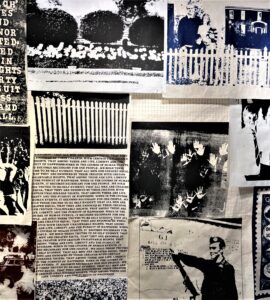
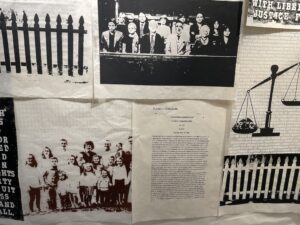
The white people are passive, but collectively they create a wall of oblivious privilege. Interspersed with the images are repeated quotes from the declaration of independence underscoring the racism of the white founders as they wrote of equality even as slavery was perpetuated and black people denied all rights.
Inserted every few feet is a mirror. We can see our own white faces as part of the white racist gaze, or for a visitor of color, surrounded by this wall of privileged exclusion.
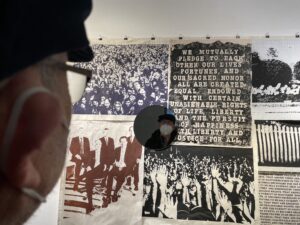
We turn from this immersion in whiteness to the second part of the installation, Regard: White Gaze. Thick glass squares hanging from the ceiling painted with blue eyes that gaze directly at us. A literal white gaze, the glass feels claustrophobic as we observe it more closely, suggesting the feeling of being watched, judged, monitored, and even threatened simply by the act of looking. It is very difficult to walk through this intense forest of glass panes, another wall of privilege, so we walk around it.
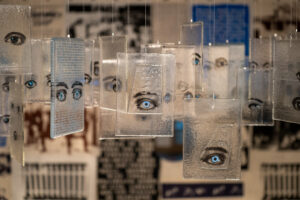
Photograph by Susan Fried

photograph by Henry Matthews
The third part of the installation Repair suggests actions to counter racism. There is going to be a closing on February 17 5-7 pm(hopefully) in which people wear signs that have references to various aspects of ways to counter racism. On one side of the sign is an oblique reference. You have to turn the sign over in order to know what it means. In other words you have to do more than look at the sign.
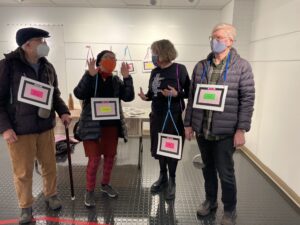
Then once you turn it over a wide range of possible ways forward are offered some educational, some personal, some joining with others. They include references to the 1619 project, a history of slavery and the roots of racism. Another explains red lining, a third “12 out of 18” lists the 12 Presidents out of the first 18 who owned slaves. Other actions suggest observing microaggressions, euphemisms. And of course speaking to our elected representatives about racism is one of the suggestions and supporting diverse cultural organizations. Revolution is not included but volunteering on projects related to the Criminal Justice System is one of the more specific community actions.
The Rosetta Hunter Art Gallery Seattle Central College 1701 Broadway, 2BE2116 Seattle, WA 98122
206.934.4379 Hours10:00 a.m. to 2:00 p.m. Monday through Thursday Admission is free. They have briefly closed because of COVID concerns but new dates are February 8 – March 24
Christina Reed received support for this project and did much of her research at the historic home and library of the James and Janie Washington Cultural Center 1816 26th ave in the Central District. If you want to know more about this important artist, come to the unveiling of a bronze statue of Dr. James W. Washington and the restored “Fountain of Triumph” Washington’s last public monument. The “Fountain,” formerly located on 23rd ave, addresses salmon migration as a metaphor of the difficulties of survival for African Americans. The Event will be at 24th and Union part of the newly built Midtown Center, February 26, 2022, 6:30pm to 8:30pm. Call the Washington Foundation for Information 206-709-4241.